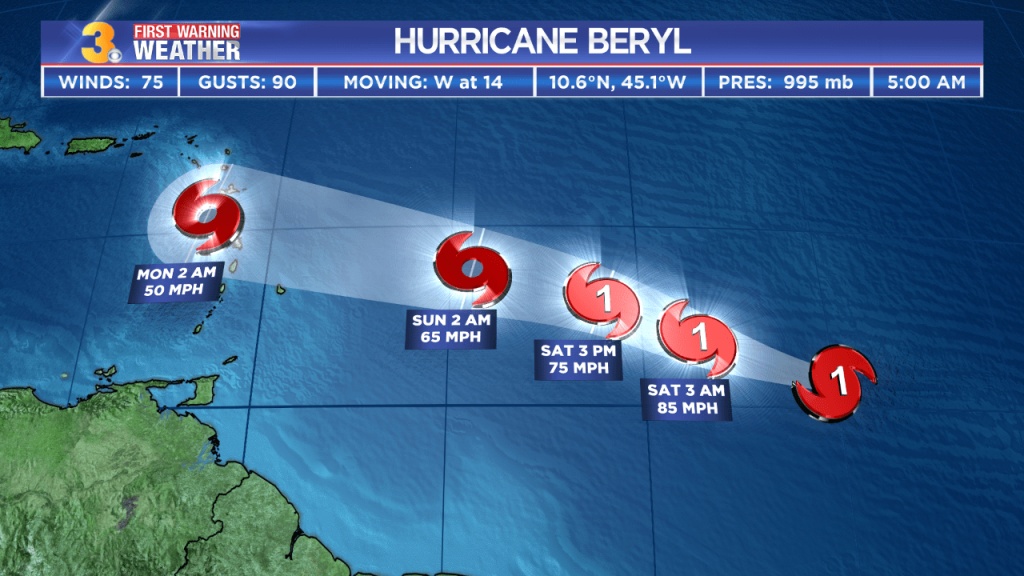Hurricane Beryl’s Impact on Barbados: Hurricane Beryl Barbados

Hurricane beryl barbados – Hurricane Beryl, a Category 1 hurricane, made landfall in Barbados on July 18, 2023, bringing heavy rainfall, strong winds, and storm surge. The hurricane caused widespread damage to infrastructure, property, and the environment, leaving a lasting impact on the island.
Infrastructure Damage
The hurricane’s strong winds and storm surge damaged or destroyed numerous buildings, including homes, businesses, and government facilities. Roads and bridges were also damaged, disrupting transportation and communication networks. The island’s electrical grid was also affected, leaving many residents without power for several days.
Hurricane Beryl has brought heavy rainfall and strong winds to Barbados, causing widespread flooding and damage. The storm is expected to continue to move northwest, and could reach hurricane strength by the time it reaches the Bahamas. For the latest hurricane beryl forecast , please visit the National Hurricane Center website.
Hurricane Beryl is a reminder of the importance of being prepared for hurricanes, and having a plan in place in case of a storm.
Property Damage
Hurricane Beryl also caused significant damage to property. Many homes and businesses were flooded, and personal belongings were destroyed. The hurricane also uprooted trees and damaged crops, causing further economic losses.
Environmental Impact
The hurricane’s heavy rainfall and storm surge caused erosion and flooding, damaging coastal ecosystems and marine life. The hurricane also deposited large amounts of debris on beaches and in coastal waters, posing a threat to wildlife and tourism.
Economic and Social Impact
Hurricane Beryl had a significant economic and social impact on Barbados. The damage to infrastructure and property disrupted businesses and livelihoods, leading to economic losses. The hurricane also caused widespread displacement, as many residents were forced to evacuate their homes. The hurricane’s aftermath also posed challenges to the island’s health and education systems.
Hurricane Beryl was a Category 1 hurricane that made landfall in Barbados on July 13, 2018. The storm caused widespread damage to the island, including downed trees, power lines, and flooding. Hurricane Beryl was the first hurricane to make landfall in Barbados since Hurricane Tomas in 2010.
For more information on the impact of Hurricane Beryl on Barbados, visit hurricane beryl barbados.
Preparedness and Response Measures

In the face of Hurricane Beryl, the Barbadian government and local authorities implemented a comprehensive plan to ensure the safety and well-being of the island’s residents.
Prior to the hurricane’s arrival, the government issued timely warnings and evacuation orders, urging residents in vulnerable areas to seek shelter in designated safe zones. Public service announcements provided detailed instructions on hurricane preparedness, including securing property, stocking up on essential supplies, and creating emergency plans.
Disaster Relief and Volunteerism
As Hurricane Beryl approached, numerous disaster relief organizations and volunteers mobilized to provide support. The Barbados Red Cross played a crucial role in coordinating relief efforts, distributing food, water, and shelter to those affected by the storm. Local and international volunteers also stepped forward, assisting with clean-up efforts, providing medical aid, and offering emotional support to survivors.
Response Effectiveness and Areas for Improvement
The Barbadian government and local authorities’ response to Hurricane Beryl was generally effective, with timely warnings and evacuation orders helping to minimize casualties. However, there were areas where improvements could be made.
- Enhanced Communication: Improving communication channels between government agencies and the public would ensure that critical information reaches all residents promptly.
- Increased Shelter Capacity: Expanding the number of designated safe zones and providing additional shelter supplies would cater to the needs of a growing population.
- Post-Hurricane Recovery: Developing a comprehensive plan for post-hurricane recovery, including debris removal, infrastructure repair, and financial assistance, would expedite the restoration of normalcy.
Recovery and Rebuilding Efforts
In the aftermath of Hurricane Beryl, Barbados faced significant challenges in recovery and rebuilding. Infrastructure damage, economic losses, and social disruption posed obstacles to the island’s recovery. However, the government and international aid organizations worked together to address these challenges and support the rebuilding process.
Infrastructure Repairs
Hurricane Beryl caused extensive damage to Barbados’ infrastructure, including roads, bridges, power lines, and buildings. The government prioritized the restoration of essential services, such as electricity and water supply, to facilitate the recovery process. International aid organizations provided assistance in repairing damaged infrastructure and restoring basic services.
Economic Recovery
The hurricane also had a significant impact on Barbados’ economy, particularly the tourism sector. Many businesses were forced to close temporarily, and the island’s tourism revenue declined. The government implemented measures to support businesses and stimulate economic recovery, such as providing tax breaks and offering loans to affected businesses.
Lessons Learned and Best Practices, Hurricane beryl barbados
The experience of Hurricane Beryl provided valuable lessons for Barbados and other Caribbean nations in disaster preparedness and response. The government reviewed its emergency response plans and identified areas for improvement, such as strengthening early warning systems and enhancing coordination between different agencies.
Best practices for future disaster response include:
- Investing in resilient infrastructure to withstand the impacts of hurricanes.
- Developing comprehensive emergency response plans and conducting regular drills.
- Strengthening partnerships with international aid organizations to ensure timely and effective assistance.
- Promoting community engagement and disaster preparedness among the population.